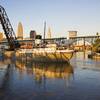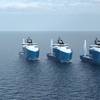International cargo volumes in the Port of New York and New Jersey hit record levels in 2005, New Jersey Governor Jon S. Corzine, Port Authority Chairman Anthony R. Coscia and Port Authority Vice Chairman Charles A. Gargano said today as they revealed new port security initiatives, including a public-private task force and a demonstration of technology to enhance security at the East Coast’s largest seaport.
During a press conference at the APM Terminal at the Elizabeth-Port Authority Marine Terminal, Governor Corzine, Chairman Coscia and Vice Chairman Gargano noted the following highlights and initiatives:
Containerized cargo volumes in the Port of New York and New Jersey rose 7.6 percent in 2005 to a new record high, continuing to exceed the authority’s projected cargo growth levels. The dollar value of all cargo moving through the port exceeded $132 billion for the first time, up 15.6 percent from 2004. The record cargo volume was attributed to a 17 percent increase in trade with Far East Asia and a 15 percent increase in trade with Southeast Asia, a trend that began three years ago.
ExpressRail, the Port Authority’s rail terminal network in New Jersey, attained a new record, handling 303,032 containers in 2005, nearly 7 percent more than in 2004.
A port security task force, led by Chairman Coscia, will study ways to enhance port security, and develop recommendations in six months.
A pilot test is under way to track the status of approximately 25 cargo containers from their points of origin to their destinations. The first containers that are part of the program have left Europe and will arrive here on or about March 13.
Port Authority Port Commerce Director Richard M. Larrabee said that in 2005, the total amount of containerized cargo handled in the Port of New York and New Jersey – measured in 20-foot equivalent units (TEUs) – totaled 4,792,922, a 7 percent increase over the 2004 total of 4,478,480 TEUs and a new annual record. The total value of all cargo handled in 2005 – more than $132 billion – surpassed the previous record of $114 billion, Mr. Larrabee said.
The Port Import-Export Reporting System (PIERS) reported in 2005 that loaded TEUs in 2005 totaled 3,385,003, a 7.6 percent increase over the 3,147,203 TEUs handled in the port in 2004.
Loaded imports and exports totaled 2,408,121 and 976,882 TEUs respectively.
The port’s total general cargo volumes, according to data from the U.S. Bureau of Census, increased 10.4 percent to 28,132,497 metric tons in 2005, compared to 25,474,164 metric tons in 2004. General cargo imports totaled 20,236,519 metric tons in 2005, a 9 percent increase over the 2004 import volume of 18,572,460 metric tons. General cargo exports also increased, by 14.4 percent, from 6,901,704 metric tons in 2004 to 7,895,978 metric tons in 2005.
Total bulk cargo was up 2.6 percent to 56,621,526 metric tons in 2005, compared to 55,169,827 metric tons in 2004. Total bulk cargo imports increased from 51,768,248 metric tons in 2004 to 53,449,638 metric tons in 2005. Total bulk cargo exports decreased by 6.8 percent, from 3,401,579 metric tons in 2004 to 3,171,888 metric tons in 2005. Total cargo volumes (bulk and general cargo combined) grew by 5.1 percent, from 80,643,991 metric tons in 2004 to 84,754,023 metric tons in 2005.
The number of automobiles handled, including small trucks, vans, SUVs and other personal vehicles, was nearly identical to the 2004 numbers. There were 722,411 units handled in 2005.
Other 2005 trade highlights include:
China continues to be the port’s largest trading partner, accounting for 22.6 percent of the port’s overall cargo volumes. Trade with China grew 25 percent in 2005. In addition, Asia continues to be the port’s largest market for containerized cargo, with a 46 percent share.
China, Italy, Germany, India and Brazil are the port’s top five trading partners for general cargo.
The top three import cargo commodities on a tonnage basis were beverages, vehicles and plastic. The top three export cargo commodities were wood pulp, plastic and machinery.
The volume of exports to India increased 52 percent over 2004. The main commodities were wood pulp, iron and steel scrap and machinery. The volume of exports to Russia increased by 40 percent over 2004. The major commodities were vehicles and meat.
The volume of imports from Belgium increased 22 percent over 2004. The major commodities were beer and plastic.
Two new all-water services from Asia to the Port of New York and New Jersey were launched in 2005 – one via the Panama Canal and one via the Suez Canal. This brings the total number of all-water services to 22.
There were 5,322 ship calls to the Port of New York and New Jersey in 2005, compared to 5,288 in 2004.
Authority Puts Focus on Port Security
With robust cargo growth forecast to continue this year, Chairman Coscia said it was imperative that closer scrutiny be given to port security issues.
The Chairman named the following individuals to serve on a port security task force and asked them to report back in six months with recommendations: Charles Gargano, Chairman and CEO of the Empire State Development Corporation and Vice Chairman of the Port Authority; Virginia Bauer, Secretary and CEO of the New Jersey Commerce and Economic Growth Commission; Robert Catell, Chairman and CEO of KeySpan Corporation; Arthur Ryan, Chairman and CEO, The Prudential Life Insurance Company of America; Kathryn Wylde, President and CEO, The Partnership for New York City; James Tisch, President, Lowes Corporation; John Degnan, Vice Chairman and Chief Administrative Officer, Chubb Insurance; Ken Gilman, President and CEO, Asbury Automotive; Paul Fribourg, Chairman and CEO, ContiGroup Companies; and Patricia Campos, Director, New Jersey State Council, UNITE HERE.
Operation Safe Commerce Technology Introduced
Following the news conference, Governor Corzine and Chairman Coscia witnessed a demonstration of cutting-edge technology being tested to track the status of a limited number of cargo containers from their points of origin to their destinations.
The test culminates three years of work by Operation Safe Commerce, a federally funded maritime consortium of agencies and organizations exploring ways to better secure the nation’s ports.
The Port of New York and New Jersey is the only East Coast port participating in the pilot test.
On the West Coast, the ports of Los Angeles and Long Beach, and the ports of Seattle and Tacoma are participating in a similar test using different technology.
Each of the containers to be tracked will contain a cigar-size “black box,” known as a Container Security Unit (CSU) and consisting of five sensors that will monitor the container’s position through global positioning satellites, and sensors to monitor whether the door has been opened, whether light is entering the container, and whether the container has any traces of radiation or carbon monoxide. The CSU will provide immediate information on the container’s position and also signal if the container has been breached or if another anomaly has been detected.
If the initial pilot test is successful, the test program will be expanded to monitor up to 1,000 containers from March through October.
When the test concludes in October, officials will prepare a report on the results of the test and use those results to help create worldwide standards that could be implemented by the federal government and the International Maritime Organization. The organization also will recommend CSU performance standards that can create a competitive industry for developing and producing the technology.
Featured videos

Inside the Electrified Truckable Tug

Inmarsat Enhances Service to Drive Digitalization

Tracking Foreign Vessels Working in the U.S. Jones Act Market
Subscribe for
Maritime Reporter E-News
Maritime Reporter E-News is the maritime industry's largest circulation and most authoritative ENews Service, delivered to your Email five times per week








